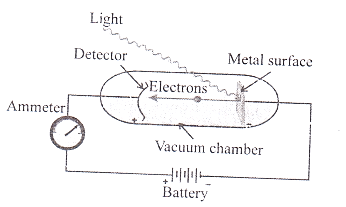Ask questions which are clear, concise and easy to understand.
Ask QuestionPosted by Himanshu Rajput 2 years, 11 months ago
- 5 answers
Account Deleted 3 years ago
Posted by Himanshu Rajput 3 years ago
- 1 answers
Posted by Dharshini Priya 3 years ago
- 1 answers
Preeti Dabral 3 years ago
Prisms can be made from any material that is transparent to the wavelengths for which they are designed. Typical materials include glass, plastic and fluorite.
Posted by Radhika Poojari 3 years ago
- 0 answers
Posted by Aman Sharma 3 years ago
- 1 answers
Preeti Dabral 3 years ago
Kinetic energy gained by charged particle of charge q when accelerated under a potential difference V will be KE=qV
For a given V,KE∝q
For proton, deuteron and α-particle the ratio of charges is 1:1:2
Posted by Tanish Batla 2 years, 6 months ago
- 1 answers
Preeti Dabral 3 years ago
Results of Project to investigate the dependence of angle of deviation on angle of incidence using a hollow prism filled one by one with different transparent liquids is as follows;
The angle of minimum deviation for –
Water D = 23⁰C
Kerosene oil D = 33⁰C
Turpentine oil D = 32⁰C
The refractive indices of the-
Water n = 1.32
Kerosene oil n = 1.46
Turpentine oil n = 1.44
Speed of light in-
Water v = 2.3x10 m/s
Kerosene oil v = 2.05x10 m/s
Turpentine oil v = 2.08x10 m/s
Posted by Veda Sri Rasamsetty 3 years, 1 month ago
- 1 answers
Anjan Karthi 3 years, 1 month ago
Posted by Shivu Gayri 3 years, 1 month ago
- 1 answers
Preeti Dabral 3 years, 1 month ago
Sophie was a dreamer who often made up stories for herself and for others. One possibility might be that she wanted to escape the squalor of daily life with the help of her fantasies. Her encounter with Danny Casey was a made-up story for the sake of catching her brother’s attention. Eventually, she gets so much engrossed in it that she starts to live the fantasy. When Danny Casey does not arrive for the second ‘date’, she experiences disappointment. However painful and disappointing her fantasy might be, she was not willing to accept reality. Her dreams and disappointments are figments of her imagination.
Posted by Ritesh Sharma 3 years, 1 month ago
- 2 answers
Anjan Karthi 3 years, 1 month ago
Posted by Soumyadeep Dafadar 3 years ago
- 1 answers
Preeti Dabral 3 years ago
The process to determine resistance per cm of a given wire by plotting a graph of potential difference versus current is given below.
- If you plot the potential difference along the X-axis and the current along the Y-axis, the reciprocal of the slope gives the material's resistance, R.
- If you interchange the quantities on the axes, the resistance will be given by its slope and not it's reciprocal.
- The resistance per cm is given by R/l if the length of the resistance wire is 'l' cm.
Posted by Rounak Anand 3 years, 1 month ago
- 3 answers
Posted by Priya Kumari 3 years, 1 month ago
- 3 answers
Posted by Vinay Pratap Singh 3 years ago
- 1 answers
Preeti Dabral 3 years ago
Radiowaves are electromagnetic waves and are produced by oscillating electronic circuits. The frequency range of radiowaves is from 3 {tex}\times{/tex} 103 to 3 {tex}\times{/tex} 1011 Hz.
Uses
- They are used in wireless communication to transmit radio and TV signals.
- Radiowaves are used in radioastronomy.
Posted by Kuldeep Raj 3 years, 1 month ago
- 1 answers
Posted by .. .... 3 years ago
- 1 answers
Preeti Dabral 3 years ago
Photoelectric effect: When certain metals are exposed to a beam of light, the electrons are ejected from the metal. This phenomenon is called the photoelectric effect. The electrons ejected are called photoelectrons.
The results of this experiment were:
- The electrons are ejected from the metal surface as soon as the beam of light strikes the surface, i.e., there is no time lag between the striking of the light beam and the ejection of electrons from the metal surface.
- The number of electrons ejected is proportional to the intensity or brightness of the light.
- For each metal; there is a minimum frequency, {tex}\nu_o{/tex} below which photoelectric effect is not observed.
- K.E. of electrons {tex}\propto{/tex} frequency of light.
Equipment for studying the photoelectric effect. Light of a particular frequency strikes a clean metal surface inside a vacuum chamber. Electrons are ejected from the metal and are counted by a detector that measures their kinetic energy:

Explanation of photoelectric effect on the basis of quantum theory: When a photon of sufficient energy strikes an electron in the atom of the metal, it transfers its energy to the electron and the electron is ejected without delay. Greater the energy of the photon, greater will be the kinetic energy of the ejected electron.
Posted by Sona , 3 years, 1 month ago
- 5 answers
Aseem Mahajan 3 years, 1 month ago
Posted by Sona , 3 years, 1 month ago
- 2 answers
Posted by Sona , 3 years, 1 month ago
- 1 answers
Posted by Sona , 3 years, 1 month ago
- 1 answers
Posted by Sona , 3 years, 1 month ago
- 1 answers
Posted by Sona , 3 years, 1 month ago
- 0 answers
Posted by Sona , 3 years, 1 month ago
- 0 answers
Posted by Sona , 3 years, 1 month ago
- 1 answers
Posted by Sona , 3 years, 1 month ago
- 0 answers

myCBSEguide
Trusted by 1 Crore+ Students

Test Generator
Create papers online. It's FREE.

CUET Mock Tests
75,000+ questions to practice only on myCBSEguide app
 myCBSEguide
myCBSEguide
Anjan Karthi 3 years ago
0Thank You